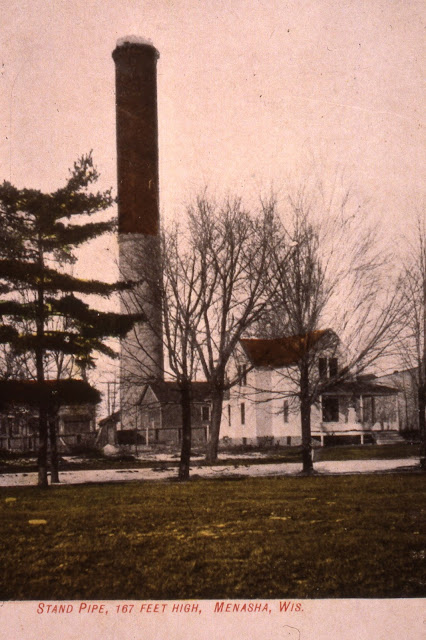With recent talk on Facebook about razing the current Menasha water tower, let's head back to the early part of the 20th century before that water tower was a gleam in the city engineer's eye.
In July 1904, the Oshkosh Daily Northwestern, reported that George Cadogan Morgan of Morgan
Engineering in Chicago had been hired to draw the plans and writing the specifications for the new
plant, which was to be powered by a diesel-fueled electric generator as opposed to a steam boiler.
Morgan had already built plants in New London, De Pere and Watertown and another was, at that
time, under construction in Sheboygan. Contracts were let in February 1905 and 11 miles of water
mains were laid and nearly 90 fire hydrants were installed; the water was turned on in November.
Aside from the plant itself, the system included an engine house, a home for the engineer and a 135-
foot-tall stand pipe to store water and generate pressure. The building was added on to by no later
than 1913 and also functioned as the electric lighting plant for the city (electric lighting would later
be provided by the River Street facility, See discussion for 199 River Street). Construction of a two-
story, water purification plant began in 1927 and was completed the following year and an additional
wing was constructed between 1947 and 1948. Finally, the eastern end of the facility appears to have
undergone more recent alterations. Indeed, in 1978, a collector system, piping and a decanter tank
were added; a chlorine room was also constructed. Ten years later, a new reservoir and pump station
were built and a $12.8 million upgrade to the filtration system was completed in 2008.36
In July 1904, the Oshkosh Daily Northwestern, reported that George Cadogan Morgan of Morgan
Engineering in Chicago had been hired to draw the plans and writing the specifications for the new
plant, which was to be powered by a diesel-fueled electric generator as opposed to a steam boiler.
Morgan had already built plants in New London, De Pere and Watertown and another was, at that
time, under construction in Sheboygan. Contracts were let in February 1905 and 11 miles of water
mains were laid and nearly 90 fire hydrants were installed; the water was turned on in November.
Aside from the plant itself, the system included an engine house, a home for the engineer and a 135-
foot-tall stand pipe to store water and generate pressure. The building was added on to by no later
than 1913 and also functioned as the electric lighting plant for the city (electric lighting would later
be provided by the River Street facility, See discussion for 199 River Street). Construction of a two-
story, water purification plant began in 1927 and was completed the following year and an additional
wing was constructed between 1947 and 1948. Finally, the eastern end of the facility appears to have
undergone more recent alterations. Indeed, in 1978, a collector system, piping and a decanter tank
were added; a chlorine room was also constructed. Ten years later, a new reservoir and pump station
were built and a $12.8 million upgrade to the filtration system was completed in 2008.36
In July 1904, the Oshkosh Daily Northwestern reported that George Cadogan Morgan of Morgan Engineering in Chicago had been hired to draw the plans and writing of the specifications for the new plant, which was to be powered by a diesel-fueled electric generator as opposed to a steam boiler. Morgan had already built plants in New London, De Pere and Watertown and another was, at that time, under construction in Sheboygan. Contracts were let in February 1905 and 11 miles of water mains were laid and nearly 90 fire hydrants were installed; the water was turned on in November. Aside from the plant itself, the system included an engine house, a home for the engineer and a stand pipe to store water and generate pressure.
June 23, 1930 Oshkosh Northwestern



















































